Antacids and dietary supplements with an influence on the gastric pH increase the risk for food sensitization
- PMID: 20214670
- PMCID: PMC2999750
- DOI: 10.1111/j.1365-2222.2010.03468.x
Antacids and dietary supplements with an influence on the gastric pH increase the risk for food sensitization
Abstract
Background: Elevation of the gastric pH increases the risk for sensitization against food allergens by hindering protein breakdown. This can be caused by acid-suppressing medication like sucralphate, H2-receptor blockers and proton pump inhibitors, as shown in recent murine experimental and human observational studies.
Objective: The aim of the present study was to assess the sensitization capacity of the dietary supplement base powder and of over-the-counter antacids.
Methods: Changes of the pH as well as of protein digestion due to base powder or antacids were measured in vitro. To examine the in vivo influence, BALB/c mice were fed codfish extract with one of the acid-suppressing substances. Read-out of antibody levels in the sera, of cytokine levels of stimulated splenocytes and of intradermal skin tests was performed.
Results: The pH of hydrochloric acid was substantially increased in vitro by base powder as well as antacids in a time- and dose-dependent manner. This elevation hindered the digestion of codfish proteins in vitro. A significant increase in codfish-specific IgE antibodies was found in the groups fed codfish combined with Rennie Antacidum or with base powder; the latter also showed significantly elevated IgG1 and IgG2a levels. The induction of an anaphylactic immune response was proven by positive results in intradermal skin tests.
Conclusions: Antacids and dietary supplements influencing the gastric pH increase the risk for sensitization against allergenic food proteins. As these substances are commonly used in the general population without consulting a physician, our data may have a major practical and clinical impact.
Figures





Similar articles
-
Antacid medication inhibits digestion of dietary proteins and causes food allergy: a fish allergy model in BALB/c mice.J Allergy Clin Immunol. 2003 Sep;112(3):616-23. doi: 10.1016/s0091-6749(03)01719-6. J Allergy Clin Immunol. 2003. PMID: 13679824
-
The impact of aluminium in acid-suppressing drugs on the immune response of BALB/c mice.Clin Exp Allergy. 2007 Oct;37(10):1566-73. doi: 10.1111/j.1365-2222.2007.02813.x. Epub 2007 Sep 10. Clin Exp Allergy. 2007. PMID: 17850381
-
Anti-acids lead to immunological and morphological changes in the intestine of BALB/c mice similar to human food allergy.Exp Toxicol Pathol. 2008 Aug;60(4-5):337-45. doi: 10.1016/j.etp.2008.03.004. Epub 2008 Jun 4. Exp Toxicol Pathol. 2008. PMID: 18524557
-
[Mechanisms and risk factors for type 1 food allergies: the role of gastric digestion].Wien Med Wochenschr. 2012 Dec;162(23-24):513-8. doi: 10.1007/s10354-012-0154-4. Epub 2012 Nov 19. Wien Med Wochenschr. 2012. PMID: 23160973 Review. German.
-
The role of protein digestibility and antacids on food allergy outcomes.J Allergy Clin Immunol. 2008 Jun;121(6):1301-8; quiz 1309-10. doi: 10.1016/j.jaci.2008.04.025. J Allergy Clin Immunol. 2008. PMID: 18539189 Free PMC article. Review.
Cited by
-
Guidelines on the management of IgE-mediated food allergies: S2k-Guidelines of the German Society for Allergology and Clinical Immunology (DGAKI) in collaboration with the German Medical Association of Allergologists (AeDA), the German Professional Association of Pediatricians (BVKJ), the German Allergy and Asthma Association (DAAB), German Dermatological Society (DDG), the German Society for Nutrition (DGE), the German Society for Gastroenterology, Digestive and Metabolic Diseases (DGVS), the German Society for Oto-Rhino-Laryngology, Head and Neck Surgery, the German Society for Pediatric and Adolescent Medicine (DGKJ), the German Society for Pediatric Allergology and Environmental Medicine (GPA), the German Society for Pneumology (DGP), the German Society for Pediatric Gastroenterology and Nutrition (GPGE), German Contact Allergy Group (DKG), the Austrian Society for Allergology and Immunology (Æ-GAI), German Professional Association of Nutritional Sciences (VDOE) and the Association of the Scientific Medical Societies Germany (AWMF).Allergo J Int. 2015;24:256-293. doi: 10.1007/s40629-015-0074-0. Epub 2015 Nov 7. Allergo J Int. 2015. PMID: 27069841 Free PMC article. No abstract available.
-
Understanding sex differences in the allergic immune response to food.AIMS Allergy Immunol. 2022;6(3):90-105. doi: 10.3934/allergy.2022009. Epub 2022 Jul 6. AIMS Allergy Immunol. 2022. PMID: 38314333 Free PMC article.
-
The Effect of Digestion and Digestibility on Allergenicity of Food.Nutrients. 2018 Aug 21;10(9):1129. doi: 10.3390/nu10091129. Nutrients. 2018. PMID: 30134536 Free PMC article. Review.
-
Use of acid-suppressive drugs in pregnancy and the risk of childhood asthma: bidirectional crossover study using the general practice research database.Drug Saf. 2013 Nov;36(11):1097-104. doi: 10.1007/s40264-013-0093-z. Drug Saf. 2013. PMID: 24018582 Free PMC article.
-
A distinct microbiota composition is associated with protection from food allergy in an oral mouse immunization model.Clin Immunol. 2016 Dec;173:10-18. doi: 10.1016/j.clim.2016.10.009. Epub 2016 Oct 24. Clin Immunol. 2016. PMID: 27789346 Free PMC article.
References
-
- Schöll I, Untersmayr E, Bakos N, et al. Antiulcer drugs promote oral sensitization and hypersensitivity to hazelnut allergens in BALB/c mice and humans. Am J Clin Nutr. 2005;81:154–60. - PubMed
-
- Untersmayr E, Schöll I, Swoboda I, et al. Antacid medication inhibits digestion of dietary proteins and causes food allergy: a fish allergy model in BALB/c mice. J Allergy Clin Immunol. 2003;112:616–23. - PubMed
-
- Black JW, Duncan WA, Durant CJ, Ganellin CR, Parsons EM. Definition and antagonism of histamine H 2 -receptors. Nature. 1972;236:385–90. - PubMed
Publication types
MeSH terms
Substances
Grants and funding
LinkOut - more resources
Full Text Sources
Medical
Research Materials

